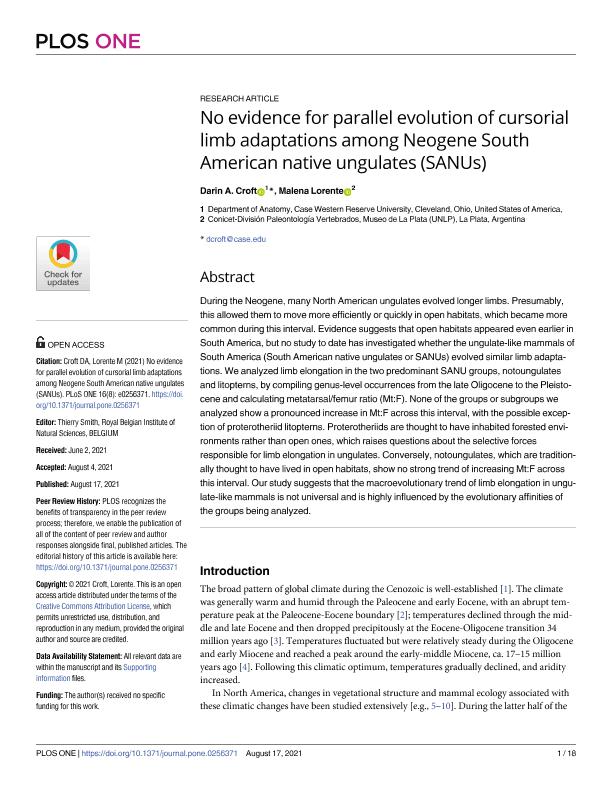Artículo
No evidence for parallel evolution of cursorial limb adaptations among Neogene South American native ungulates (SANUs)
Fecha de publicación:
08/2021
Editorial:
Public Library of Science
Revista:
Plos One
ISSN:
1932-6203
Idioma:
Inglés
Tipo de recurso:
Artículo publicado
Clasificación temática:
Resumen
During the Neogene, many North American ungulates evolved longer limbs. Presumably, this allowed them to move more efficiently or quickly in open habitats, which became more common during this interval. Evidence suggests that open habitats appeared even earlier in South America, but no study to date has investigated whether the ungulate-like mammals of South America (South American native ungulates or SANUs) evolved similar limb adaptations. We analyzed limb elongation in the two predominant SANU groups, notoungulates and litopterns, by compiling genus-level occurrences from the late Oligocene to the Pleistocene and calculating metatarsal/femur ratio (Mt:F). None of the groups or subgroups we analyzed show a pronounced increase in Mt:F across this interval, with the possible exception of proterotheriid litopterns. Proterotheriids are thought to have inhabited forested environments rather than open ones, which raises questions about the selective forces responsible for limb elongation in ungulates. Conversely, notoungulates, which are traditionally thought to have lived in open habitats, show no strong trend of increasing Mt:F across this interval. Our study suggests that the macroevolutionary trend of limb elongation in ungulate- like mammals is not universal and is highly influenced by the evolutionary affinities of the groups being analyzed.
Palabras clave:
Litopterna
,
Apendicular skeleton
,
Morphofuctional Anatomy
,
Neogene
Archivos asociados
Licencia
Identificadores
Colecciones
Articulos(CCT - LA PLATA)
Articulos de CTRO.CIENTIFICO TECNOL.CONICET - LA PLATA
Articulos de CTRO.CIENTIFICO TECNOL.CONICET - LA PLATA
Citación
Croft, Darin; Lorente, Malena; No evidence for parallel evolution of cursorial limb adaptations among Neogene South American native ungulates (SANUs); Public Library of Science; Plos One; 16; 8; 8-2021; 1-18
Compartir
Altmétricas




